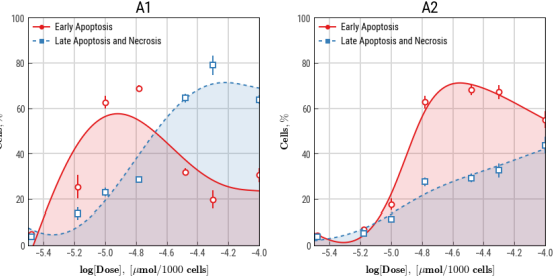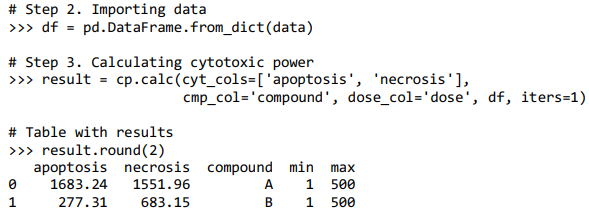CYTPOWER: РЕАЛИЗАЦИЯ КОНЦЕПЦИИ ЦИТОТОКСИЧЕСКОЙ МОЩНОСТИ НА ЯЗЫКЕ PYTHON
DOI: https://doi.org/10.18454/jbg.2018.4.9.1
Terpilovskii M.A.*1, Goncharov N.V. 2
1, 2 Sechenov Institute of Evolutionary Physiology and Biochemistry, Saint-Petersburg, Russia
* Correspodning author (maximtrp@gmail.com)
Received: 9.10.2018; Accepted: 18.10.2018; Published: 15.11.2018
CYTPOWER: IMPLEMENTATION OF CYTOTOXIC POWER CONCEPT IN PYTHON
Application notes
Abstract
Currently existing methods and parameters are inadequate for representative and quanititative assessment of cytotoxic activity of chemical compounds. Recently, we have introduced a concept of cytotoxic power which provides an effective way to a reasonable estimation and comparative analysis of cytotoxic activity of chemical agents. The basis of this concept is an integrative parameter that relies on important toxicological principles: dose of compound related to a cell number and exposuretime-response relationship of its activity. Herein, we propose an implementation of our concept of cytotoxic power as a package developed in Python programming language. The package is free and available on GitHub repository.
Keywords: cytotoxicity, apoptosis, necrosis, computational biology.
Терпиловский М.А.*1 , Гончаров Н.В. 2
1, 2 Институт эволюционной физиологии и биохимии имени И. М. Сеченова РАН, Санкт-Петербург, Россия
* Корреспондирующий автор (maximtrp@gmail.com)
Получена: 9.10.2018; Доработана: 18.10.2018; Опубликована: 23.10.2018
CYTPOWER: РЕАЛИЗАЦИЯ КОНЦЕПЦИИ ЦИТОТОКСИЧЕСКОЙ МОЩНОСТИ НА ЯЗЫКЕ PYTHON
Техническая спецификация
Аннотация
Существующие методы и показатели непригодны для репрезентативной характеристики и количественной оценки цитотоксической активности химических веществ. Ранее предложенная нами концепция цитотоксической мощности позволяет объективно оценивать и проводить сравнительный анализ цитотоксической активности различных агентов. В основе концепции лежит интегративный показатель, учитывающий важнейшие токсикологические принципы: дозу вещества в пересчете на количество клеток и временную зависимость действия вещества. В данной работе мы предлагаем реализацию данной концепции в виде пакета cytpower на языке программирования Python. Пакет является бесплатным и доступен для скачивания в репозиториях PyPi и GitHub.
Ключевые слова: цитотоксичность, апоптоз, некроз, математическая биология.
Multiple types of cell death have been described: apoptosis, necrosis, autophagy, necroptosis, paraptosis, pyroptosis, anoikis, ferroptosis, etc [1]. Ability of chemical agents to induce apoptosis and necrosis is crucial for development of effective anti-cancer drugs. Compounds that exhibit high proapoptotic activity are considered promising for pre-clinical studies [2, 3]. However, existing methodological procedures for activity assessment need significant improvement. “Apoptotic index”, “apoptotic threshold” and “apoptotic potential” that are used to evaluate cytotoxic activity of chemical agents are not based on toxicological principles [4-7], including compound dose and dose-response relationship. These measures are mostly qualitative, exploratory and suitable only for basic examination of experimental results. Recently, we have introduced a concept of cytotoxic power that is an integrative parameter based on the above principles [8]. Cytotoxic power can be used to assess any type of cell death based on corresponding specific and/or non-specific cellular markers (as a rule, epigenetic in its nature, named phens). It is computed as a definite integral of a dose-response function divided by time delta. For instance, we can obtain cytotoxic power values for multiple cell indices: percentage of early apoptotic cells or late apoptotic and necrotic cells. These data may be further processed with basic and advanced statistical methods (such as ANOVA), multiple-criteria decision analysis (MCDA) or quantitative structure-activity relationship (QSAR) models.

where  is a compound dose,
is a compound dose,  is a dose-response function,
is a dose-response function,  is incubation duration,
is incubation duration,  is minimal dose, and
is minimal dose, and  is maximum dose. Thus, unit of cytotoxic power is mol % per number of cells per hour. This equation can be extended to a sum of integrals to calculate total cytotoxic power over multiple indices. By default, spline is used to fit dose curves, but one can specify compound—function pairs to control the fitting process, e.g. sigmoid for compound 1, polynomial for compound 2. Bootstrapping is applied to obtain multiple cytotoxic power values for multiple experimental results (number of iterations may be specified manually). The algorithm of cytotoxic power calculation can be reduced to three steps:
is maximum dose. Thus, unit of cytotoxic power is mol % per number of cells per hour. This equation can be extended to a sum of integrals to calculate total cytotoxic power over multiple indices. By default, spline is used to fit dose curves, but one can specify compound—function pairs to control the fitting process, e.g. sigmoid for compound 1, polynomial for compound 2. Bootstrapping is applied to obtain multiple cytotoxic power values for multiple experimental results (number of iterations may be specified manually). The algorithm of cytotoxic power calculation can be reduced to three steps:
1) Define the interval of effective doses (integration interval).
2) Choose an approximating function to fit dose-response relationship.
3) Compute the definite integral of a dose-response function and divide it by time delta. Optionally, sum definite integrals of functions to get the overall cytotoxic power based on cell death percentages or cellular markers (e.g. early apoptosis + late apoptosis and necrosis).

Figure 1. Dose-response relationship of cytotoxic activity of compounds A1 and A2 plotted by cytpower package
We have implemented the algorithm for calculating cytotoxic power as a package in Python programming language (https://www.python.org). The package provides two convinient functions to explore and plot results and compute cytotoxic power values: calc() and plot() methods. Cytpower is based on Numpy ndarrays that are optimized for fast and scalable computations and Pandas DataFrame objects to store, process, and export data to Excel, CSV, or any available format. The package is freely available on PyPi and GitHub (https://github.com/maximtrp/cytpower). Typical procedure starts with (1) obtaining results and creating a dataset, (2) importing data with a Pandas read function, and choosing data columns according to cytpower API. Calling plot() method results in rendering publication-ready plots and can be used to explore data. Example plots are shown in Fig. 1. Final step is (3) calling calc() method to obtain cytotoxic power values.
We provide a simple example of cytpower use with Pandas:

There are two compounds (“A” and “B”), the percentage values of apoptotic and necrotic cells, and dose values in this example dataset. Pandas from_dict() method will take Python dictionary keys as column names and values as indexed rows.

This table contains cytotoxic power values in “apoptosis” and “necrosis” columns. These results suggest that compound “A” is more powerful than compound “B”. Here, the results of a single experiment were processed with cytpower. But one can specify multiple values for each cell marker and dose. We also provide a complex cytotoxicity analysis workflow with basic statistics in a Jupyter Notebook on GitHub. Thus, cytpower package can be used to plot, calculate and compare cytotoxic power values of chemical agents analyzed with various cellular assays.
Funding
These studies were supported by State assignment AAAA-A18-118012290142-9.
Финансирование
Исследование выполнено при помощи государственного гранта AAAA-A18-118012290142-9.
Conflict of Interest
None declared.
Конфликт интересов
Не указан.
Список литературы
Saeed W.K., Jun D.W. Necroptosis: An emerging type of cell death in liver diseases // World J Gastroenterol. — 2014. — Т. 20. — №. 35. — С. 12526-12532
Smetanin I.A., Novikov M.S., Agafonova A.V., Rostovskii N.V., Khlebnikov A.F., Kudryavtsev I.V., Terpilowski M.A., Serebriakova M.K., Trulioff A.S., Goncharov N.V. A novel strategy for the synthesis of thermally stable and apoptosis-inducing 2,3-dihydroazetes // Org. Biomol. Chem. – 2016. – Т. 14. – №. 19. – С. 4479-4487.
Galenko E.E., Galenko A.V., Novikov M.S., Khlebnikov A.F., Kudryavtsev I.V., Terpilowski M.A., Serebriakova M.K., Trulioff A.S., Goncharov N.V. 4-Diazo and 4-(triaz-1-en-1-yl)-1H-pyrrole-2-carboxylates as agents inducing apoptosis. Chemistry Select. — 2017. – Т. 2. – №. 25. – С. 7508-7513.
Thompson C. B. Apoptosis in the pathogenesis and treatment of disease //Science. – 1995. – Т. 267. – №. 5203. – С. 1456-1462.
Potten C. S. What is an apoptotic index measuring? A commentary //British journal of cancer. – 1996. – Т. 74. – №. 11. – С. 1743.
Henery S., George T., Hall B., Basiji D., Ortyn W., Morrissey P. Quantitative image based apoptotic index measurement using multispectral imaging flow cytometry: a comparison with standard photometric methods //Apoptosis. – 2008. – Т. 13. – №. 8. – С. 1054.
Mooney E. E., Peris J. R., O'Neill A., Sweeney E. C. Apoptotic and mitotic indices in malignant melanoma and basal cell carcinoma //Journal of clinical pathology. – 1995. – Т. 48. – №. 3. – С. 242-244.
Goncharov N. V., Terpilowski M. A., Nadeev A. D., Kudryavtsev I. V., Serebriakova M. K., Zinchenko V. P., Avdonin P. V. Cytotoxic Power of Hydrogen Peroxide Effect on Endothelial Cells in vitro //Biochemistry (Moscow), Supplement Series A: Membrane and Cell Biology. – 2018. – Т. 12. – №. 2. – С. 180-188.
